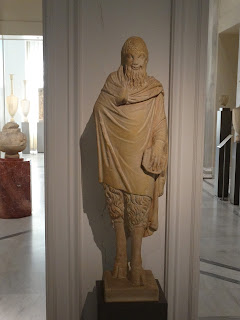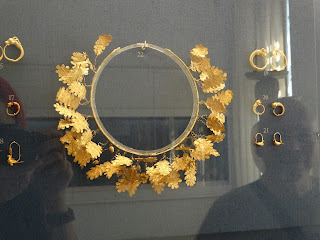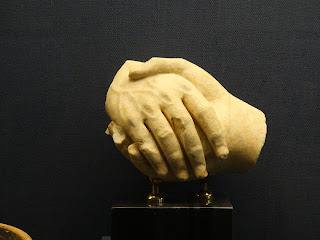This building is one of four sites for the Benaki Museum in Athens. It's on a road next to the Parliament and Amalia Gardens, a very beautiful part of the city. I love the Neo-Classical buildings of Athens.
One thing I've noticed in Athens is that the older buildings have chandeliers. I so wish I had a house with a ceiling high enough for a chandelier.
At the front of this display are bronze votive figurines of various animals, they are quite charming - 8th to 7th Century BC
Bronze pendants in the form of schematic birds, the pendant with the square openwork base may also have been used as a seal - Macedonian Iron Age 8th to 7th Century BC
Black figure amphora from an Attica workshop with sirens and felines alternating with lions - c.580 BC
Geometric Amphora from Attica with a scene showing church rites for the dead and mourners on the neck, with linear motifs, animals and warriors on the body. The snakes are interesting for their chthonic symbolism and applied white pigment - 720-700 BC
Naturalistic female figurines with hands under their breasts, some of them with swollen bellies possibly pregnant - from Kedros, Karditsa, Farsala and Larisa 6500-4500 BC
Torso of a naturalistic female figurine with her hands on her breasts, in front is a plaster model of a possible original form - from Larisa 6500-5300 BC
Cylinder seals and sealstones of semi-precious stones and gold, with representations of animals and religious scenes - 15th-14th Century BC
Spectacle fibulae with spiral discs and a finger ring with double spiral finials 10th-7th Century BC
Black glazed exaleiptron (a container for women's toilette or unguents) - c. 500 BC
Alabastra with representations of mythical creatures (sphinxes, sirens, griffin and warriors)
A black glazed komast cup depicting an ithyphallic satyr holding a horn - c. 580 BC
Gold bull's head pendant with inlaid enamel eyes - 6th - early 5th Century BC
Black figure olpe (wine jug) with figures of Dionysus, Athena and Hermes - 510-500 BC
Boeotian horse figurines, common as grave offerings either because of the status of the dead or the chthonic character of the horse - 600-550 BC
Red figure kylix, decorated with two male figures in conversation
Bronze figure of a runner from an Arcadian workshop - Early 5th Century BC
Terracotta figurines of a pig and a tortoise, usually grave offerings, they are linked to the cults of Aphrodite and Demeter respectively - 5th Century BC
When I first looked at this statue I thought Zoidberg then I noticed the feet, it's actually a cast of a statue of Pan that is now housed in the National Archeological Museum - from Sparta
White ground lekythos (vessel for storing olive oil) with most of the painted decoration lost - 440-410 BC
Boeotian terracotta figurines of women with elaborate coiffures and a young male with a cockerel in his left hand - 5th to 4th Century BC
Red figure hydria (pot for carrying water) with a scene of bridal adornment in the women's quarters, the bride is seated, Eros is offering a ribbon and there are two maidservants - c. 420 BC
Gold wreath of oak leaves and flowers - 4th-3rd Century BC
Marble grave stele showing the deceased seated and bidding farewell to her relatives, behind her stands a maidservant - from Keratea, Attica mid-4th Century BC
Gold wreath of oak leaves and flowers with an owl in a central rosette - 2nd-early 1st Century BC
Gold wreath of oak leaves and flowers - Late 4th-early 3rd Century BC
Attic black glaze pelike, vases of this type were very stable and therefore used for storing valuable oils - 350-325 BC
Gold snake bracelets. Snakes, symbols of the cult of Isis and apotropaic power that derives from the sacred cobra of Egypt, were particularly popular in Egyptian goldwork in the Late Hellenistic and Early Roman periods. From Alexandria - 1st Century BC-1st Century AD
Marble group of hands, fragment of the scene of dexiosis (farewell) from an Attic grave relief - Late 4th Century BC
Attic black glazed pyxis, decorated with modelled necklaces, originally gilded. Pyxides were used as containers for cosmetics or jewellery - 350-300 BC
Gold snake bracelets - 1st Century BC-1st Century AD
Terracotta horse head, from the applique decoration of a vase, characteristic of the pottery of Kanysion, Apulia - 300-250 BC
Bell krater (wine mixing vessel) decorated with black-painted laurel branch - 400-350 BC
Apulian red figure volute krater of the de Santis group, depicting a dead warrior in a temple shaped tomb and his relatives offering him gifts. Volute kraters of this type appeared in Apulia froom the second quarter of the 4th Century BC - 320 BC
Marble statuette of Athena - Perhaps from Asia Minor, late 2nd Century BC
In this free remodelling of Pheidias' statue of Athena Parthenos, the goddess is represented in a sleeved chiton, girdled high on the waist, and an aegis with relief gorgoneion on her bosom. The holes on her helmet were for fixing the crest and other additional figures, which included a sphinx, two pegasi and two griffins. In the original work Athena held a winged Nike in her outstretched right hand and a shield in her left.
Marble statuette of Zeus - perhaps from Asia Minor, late 2nd Century BC
The god, identified by the eagle by his left leg, is represented himation-clad with raised left hand, in which he most probably held a sceptre, while with his right he proffers possibly a phiale. The statuette belongs in a broad category of works of the late Hellenistic period, associated with domestic cult. It very probably harks back to an original creation of the late 4th Century BC.
Faience figure of the Egyptian god Bes - From Egypt, Hellenistic period.
Trefoil mouthed oinochoe, restored from a faience fragment. It belongs to a large class of Alexandrian vases representing Ptolemy queens holding the cornucopia - late 3rd Century BC
Gold wreath of ivy leaves and flowers - possibly from Macedonia 1st Century BC
Gold medallion with relief bust of the goddess Athena, with triple crested helmet and aegis with gorgoneion over her left breast. The eyes are inlaid in blue enamel. The mesh of surrounding chains indicates the piece was a kind of snood worn over the hair at the nape of the neck - from the Thessaly treasure 2nd Century BC
Gold jewellery from the Thessaly treasure, dated to 2nd Century BC. The cache was found in 1929 buried inside an ancient bronze jar near Gardiki, ancient Larisa Kremaste in Thessaly. The rest of the jewellery and numerous silver coins are in the National Archeological Museum, Athens.
Gold bracelet with emeralds, from a female grave in Piraeus - 1st Century AD
Marble head of Hekate or Tyche, from Crete - 1st-2nd Century AD
A severely damaged fragment of a large, most probably cult statue. The goddess bears a kalathos and her eyes were inlaid
Part of a mosaic with the virgin, from the Studios Monastery in Constantinople. This is the only known surviving fragment of the once renowned mosaics in the monastery - late 10th Century BC
Part of a marble iconostasis - 11th-12th Century
Parchment Codex with the Heavenly Ladder by St John Klimax. The author is depicted on the frontispiece to the left the opposite page is dominated by the ornamental headpiece with floral motifs and the initial capital - possibly from Caesarea - 11th Century
"Very Useful Great Etymological Dictionary in Alphabetical Order" Venice 1499
This is the first edition and the earliest known collaboration of the important Cretan printers, Nikolaos Vlastos and Zacharias Kalliergis, who contributed greatly to the publication of Greek books in the early years of printing. Their work is praised in verse by Markos Mousouros at the beginning of the book
Handwritten nautical atlas that contains two maps: one of the Mediterranean and one of the Aegean sea. It is attributed to the Marseilles school. Parchment - 17th Century























































No comments:
Post a Comment